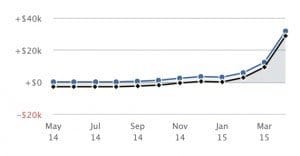How to Turn Your Site’s Traffic into Money

When you design a site, the initial concern is all about how to grow your traffic from nothing to a functional audience. Once you have that ball rolling, however, it’s time to turn to something else; monetization.
Some bloggers choose to blog for the sake of informing people about their lives. Many more, however, are blogging as part of a business. No matter what your purpose, be it personal blogging, promoting your content or selling your service, you can stand to monetize your blog. How can you convert your traffic into cash?
Advertising
Most people, when they think of monetizing a blog, instantly think of banner ads. For a long time, the Internet was absolutely plastered with these ads. The long horizontal rectangles and the tall vertical sidebars are etched into the minds of an entire generation of web users. These types of ads still exist, but their use has declined significantly since Google started penalizing over-advertised sites, alongside an increasing pool of users running adblockers.
One advertising option you can use is Google’s AdWords platform. Rather than using graphical ads that clutter your side and slow its loading, AdWords adds textual links to sponsored posts based on the context of the words. It’s still blocked by most adblockers, but it’s less intrusive and, more importantly, sanctioned by Google.
Ads can earn you a lot of money, but sometimes it takes a bit of work to reach that point. The more pages you have, the more ads you can serve, so the more your payments are going to be. Certain keywords have higher returns than others, but you’re limited in broad terms to certain industry keywords. AdWords can be very lucrative, but it will require a significant amount of testing and experimentation to reach that point.
Affiliate Advertising
A variation on AdWords, affiliate marketing is a bit more reliable but suffers from a poor reputation. Years ago, affiliate marketers were those shady black hats who cloaked their links behind redirects and hid every sign of their making money from everything you did. Today, affiliate marketing has been legitimized by Google’s harsh punishments for abusers coupled with some high profile companies making affiliate programs.
For example, you can sign up to be an Amazon affiliate. This gives you access to a control panel full of tools, all geared towards one thing; advertising Amazon products. Any time you mention a product on your blog, you can generate an Amazon Affiliate link or box, which includes your affiliate code. Post that and encourage users to buy the product, typically through a positive review of that product.
Amazon affiliates work on sales, so a click with no conversion is meaningless. Other affiliate programs will pay out for impressions or clicks, however. Impressions pay the least, while conversions pay the most, in a broad general sense.
Sell Yourself
Many bloggers blog because they love to write and keep people informed, and they’re passionate about their industry. These types of bloggers are able to use their blogs as highly visible online portfolios, where they are able to generate an income by selling their services as writers. Plenty of businesses out there want to run blogs but don’t have the time to do so. The best option for these businesses is to hide a blogger, either as a public face for their business or as a ghostwriter.
All you need to do to sell your services as a blogger is add a visible “hire me” button to your site. This button will lead to a contact page with your contact information of choice and any ground rules you want to lay down. You can include a price up front, or you can negotiate with each business individually, depending on the contract. Typically, you will want to restrict the subjects you cover, lest you flood yourself with work you’re not passionate about.
Sell a Product
Of course, if you’re a blogger running a business, you likely have a product or service to sell. Your blog then becomes an extended advertisement for that product or service. You have to keep in mind a few basic guidelines, however, or else you’ll fall out of grace with Google and will lose the faith of your readers.
Essentially, you need to use your blog as a means to convince users that you know what you’re talking about and that you’re trustworthy. Avoid being too promotional; passive sidebar ads and bounce traps can help catch users with your call to action. Content value is better than a call to action any day. If users like what you have to say, they’ll make their way to your product pages on their own. That’s where you lay on the advertising.
If you don’t have a product and you’re just running an industry blog, you can leverage that to come up with a product. The simplest and easiest product to create and sell is an app. When you have a reader base of sufficient size, you can study their needs and desires. Look for a need or a desire that is common to many of your readers and that isn’t filled by a popular app already.
Designing an app can be a time-consuming process, unfortunately. It’s possible to invest in an app developer to help streamline the process, but you still need to have a goal and system in mind.
Once you have an app, you can sell it on the iTunes store for Apple devices, or the Google Play store for Android devices. You can also try to get it on the Amazon App Marketplace, but be warned; Amazon is a bit less desirable from a consumer point of view due to their update restrictions. Even so, having your app available in every store can be beneficial.
Sell Your Content
If you’re blogging, you’re providing a constant stream of quality content to your readers on a daily or weekly basis. Why would they want to pay for what you give them for free? The answer is value; give them more than they get on your site and they’ll convert if they like what they see for free.
Ebooks can run a wide range of topics, lengths and degrees of depth. You can create a deep, customized tutorial for an industry system and sell that for a reasonable fee. You can create broad overviews of the industry as a whole, as a sort of beginner’s guide, and sell that for a pittance – or even just in exchange for social metrics.
One easy way to create and sell an ebook comes up if you have run your blog for at least a year. By that time, you should have two or three posts that are clear frontrunners in terms of ongoing traffic. Analyze those posts and determine if they can be expanded into ebooks.
For example, say you have a top 10 list of resources in the industry, and that list has become valuable and works as a great traffic driver. Take that post and expand it. Each bullet point can be expanded into a page or chapter, if the resource provides that much information. Expand it from a top 10 list to a top 20, or top 50, or however much value you want to cram into it. Users know your top 10 list was valuable; of course they’ll be willing to invest in a much better resource.
 ContentPowered.com
ContentPowered.com






